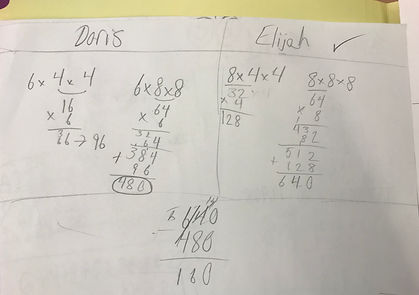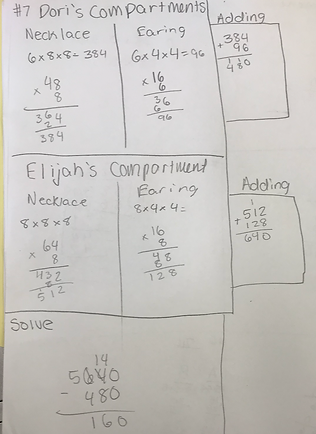Application Based Assessment
Introduction
Application-based assessments are real-world problem-solving tasks were students must utilize a number of skills both conceptually and procedurally to succeed. These tasks demonstrate a variety of assessments used in my classroom to identify each student's needs and develop differentiated learning experiences. As a result of this students gain access to the high level of rigor state tests provide.
Problem-Solving Task
The problem-solving task below assesses standard 5.MD.5.c. Although it is not the primary purpose, understanding the standards aligned to a problem-solving task help me evaluate and report on student learning with a rigorous lens. The problem shown below is a three-step problem-solving task that requires students to utilize skills in volume, multiplication, and conceptualization. While students have continuous practice and assessment with procedural learning, conceptual based learning is an important assessor in my classroom to evaluate rigor and grade-level competencies.


This piece of evidence demonstrates a student's competencies with critical thinking skills by rationalizing the task at hand. This is evident in the student separated workspace to identify Doris and Elijah's volume separately. A third section to subtract demonstrates a full understanding of the problem.

Similar to the work above, this piece of evidence demonstrates this student's ability to apply their content mastery in a rigorous manner. From this student's work, I am able to see that they understand principles in volume and two-step word problems. This is a strong accessor of preparation for problem-solving tasks they will encounter on high-stakes testing as well as in more rigorous mathematical content in 6th grade.

Different from the two pieces of work above, this piece of evidence illuminates a lack of conceptualization in mathematics. Although this student was able to correctly identify the formula for volume and apply it. They were unable to identify the third step of finding the difference. This demonstrates a need to focus on reading comprehension skills as well as problem-solving strategies such as annotations, modeling and/or writing a plan.
Teacher Reflection
Today's lesson was ok but unfortunately, I missed out on an opportunity. While developing students critical thinking skills, there are key strategies I want to see them grappling with to make sense of the problem. These strategies include annotating the problem, making a plan, writing an equation, and/or drawing a model. Next time I do this lesson, I will stress the importance of these skills and include them in the criteria for success/rubric.